 Copyright 2016 Uke 'n' Roll LLC Uke 'n' Roll Volume 1: The Complete Ukulele Method All rights reserved. No part of this book may be reproduced, stored in a retrieval system, or transmitted by any means without the written permission of the authors. ISBN 978-0-9975340-0-9
Copyright 2016 Uke 'n' Roll LLC Uke 'n' Roll Volume 1: The Complete Ukulele Method All rights reserved. No part of this book may be reproduced, stored in a retrieval system, or transmitted by any means without the written permission of the authors. ISBN 978-0-9975340-0-9
ISBN 978-0-9975340-1-6 (e-book) Graphic design by Inkwell Book Co. www.lnkwellBookCompany.com First Edition Printing, 2016 Design by Inkwell Book Co. and Pat Wittich
www.lnkwellBookCompany.com  VOLUME 1THE COMPLETE UKULELE METHOD by Samson Trinh & John Gonzalez del Solar
VOLUME 1THE COMPLETE UKULELE METHOD by Samson Trinh & John Gonzalez del Solar
Song Arrangements by Samson Trinh
Photos by Ashly Covington and Lynn Scott
Cover and Interior Design by Inkwell Book Co. and Pat Wittich For additional FREE online educational resources and for more information on classroom sets of ukuleles, accessories, lesson books, Orff and choral arrangements, visit: www.UkeNRoll.com TABLE OF CONTENTS: SECTIONSTABLE OF CONTENTS: SONGSINTRODUCTION Featured in USA TODAY, Uke 'n' Roll provides an alternative teaching method to refresh the music program in school systems and inspire the community using the world's easiest, most engaging and addictive instrument the ukulele.
TABLE OF CONTENTS: SECTIONSTABLE OF CONTENTS: SONGSINTRODUCTION Featured in USA TODAY, Uke 'n' Roll provides an alternative teaching method to refresh the music program in school systems and inspire the community using the world's easiest, most engaging and addictive instrument the ukulele.
Whether you're a ukulele enthusiast looking for the next level or a music educator searching for uke curriculum resources, this clear and concise method will bring your goals within reach the easy way. Utilizing a broad range of musical genres, Samson Trinh and John Gonzalez del Solar's lessons and song arrangements inspire participants to jam on four simple strings with just a few minutes of instruction.  THE BENEFITS OF THE UKULELE It's a small and inexpensive instrument that can fit any student, young or old. You can play and sing at the same time while gaining knowledge of music theory. The instrument is fun for teachers and students. Foundational springboard for those aspiring to learn a new instrument.
THE BENEFITS OF THE UKULELE It's a small and inexpensive instrument that can fit any student, young or old. You can play and sing at the same time while gaining knowledge of music theory. The instrument is fun for teachers and students. Foundational springboard for those aspiring to learn a new instrument.
People of all ages unanimously agree: Ukulele is a fun instrument! GETTING TO KNOW YOUR UKE UKE HISTORY In 1880, Portuguese immigrants settled in Hawaii and introduced the islanders to a small stringed instrument called a machete. Three settlers in particular, Manuel Nunes, Jos do Esprito Santo, and Augusto Dias, all woodworkers, later modified the machete to what is now known as the ukulele (which translates to jumping flea and describes the movement of the player's fingers on the fretboard). The popularity of the ukulele in Hawaiian music and culture is credited to King David Kalkaua (b. November 16, 1836 d. January 20, 1891), who passionately supported and promoted the instrument in performances to royalty and the general public. His composition, Hawai'i Pono' is the state song of Hawaii. HOW TO SAY IT The Hawaiian pronunciation is "oo - koo - leh - lay" or "ook" for short.
UKE HISTORY In 1880, Portuguese immigrants settled in Hawaii and introduced the islanders to a small stringed instrument called a machete. Three settlers in particular, Manuel Nunes, Jos do Esprito Santo, and Augusto Dias, all woodworkers, later modified the machete to what is now known as the ukulele (which translates to jumping flea and describes the movement of the player's fingers on the fretboard). The popularity of the ukulele in Hawaiian music and culture is credited to King David Kalkaua (b. November 16, 1836 d. January 20, 1891), who passionately supported and promoted the instrument in performances to royalty and the general public. His composition, Hawai'i Pono' is the state song of Hawaii. HOW TO SAY IT The Hawaiian pronunciation is "oo - koo - leh - lay" or "ook" for short.
It is commonly pronounced as "yew - ka - leh - lee" or "yook" for short. So which way is right? Say it anyway you like, or switch it up! PARTS OF THE UKE
 HI! I'M SCRUFFY! You'll see me pop up in the book to offer ukulele knowledge, musical tips and help you Geek Out, which means to intensely examine a concept or technique in effort to master it! Just look for my banner and logo!
HI! I'M SCRUFFY! You'll see me pop up in the book to offer ukulele knowledge, musical tips and help you Geek Out, which means to intensely examine a concept or technique in effort to master it! Just look for my banner and logo!  THE UKULELE FAMILY The ukulele comes in four sizes.
THE UKULELE FAMILY The ukulele comes in four sizes.  The Uke 'n' Roll Method book can be used for soprano, concert, or tenor ukuleles because all three instruments use the same Standard Tuning of G-C-E-A, also known as C tuning. The Soprano is the smallest and perhaps the most popular size. It is perfect for children with small hands and fingers but many adults and experienced players love it, too. The sound is bright and the frets are closely spaced, making it ideal for beginners.
The Uke 'n' Roll Method book can be used for soprano, concert, or tenor ukuleles because all three instruments use the same Standard Tuning of G-C-E-A, also known as C tuning. The Soprano is the smallest and perhaps the most popular size. It is perfect for children with small hands and fingers but many adults and experienced players love it, too. The sound is bright and the frets are closely spaced, making it ideal for beginners.
It is also the most affordable uke. For comfort, those with larger hands and longer or wider fingers may prefer a Concert (bigger than soprano) or Tenor (bigger than concert). These ukes sound fuller and have a longer neck with wider fret spacing. The additional frets allow for higher notes. The Baritone is the largest ukulele and uses a different tuning, D-G-B-E, which is known as G tuning. Guitar players love the baritone because it's four strings are the same as the bottom four strings on the guitar.
The lower tuning provides a deep, rich tone, but the chords and notes of the baritone are different than those of the other three sizes. TUNING THE UKULELE Ukuleles tune to the classic tones of "My Dog Has Fleas." It is highly recommended to tune and stretch the strings on a regular basis, especially if the instrument is brand new. It takes time for new ukes to dial in. They just need a lil' love! THE STAFF The Staff is the foundation of writing and reading notes and it's comprised of five lines and four spaces. TREBLE CLEF
The Staff is the foundation of writing and reading notes and it's comprised of five lines and four spaces. TREBLE CLEF The Treble Clef sign is placed at the beginning of the staff assigning notes to the lines and spaces. NOTES Each Note has a letter name and represents a different musical pitch. NOTES Each Note has a letter name and represents a different musical pitch.
The Treble Clef sign is placed at the beginning of the staff assigning notes to the lines and spaces. NOTES Each Note has a letter name and represents a different musical pitch. NOTES Each Note has a letter name and represents a different musical pitch.
As the note moves up, the pitch sounds higher. From bottom to top, the lines are E-G-B-D-F and the spaces are F-A-C-E. To help remember the lines use: Elvis' Guitar Broke Down Friday. And the spaces? They spell FACE! Sharp, Flat and Natural symbols are called Accidentals, and commonly occur in musical notation. Sharp (#) means to raise the pitch of the written note up by one half step (the distance of one fret higher in pitch). Flat (b) means to lower the pitch of the note by one half step.
Sharp, Flat and Natural symbols are called Accidentals, and commonly occur in musical notation. Sharp (#) means to raise the pitch of the written note up by one half step (the distance of one fret higher in pitch). Flat (b) means to lower the pitch of the note by one half step.
Next page





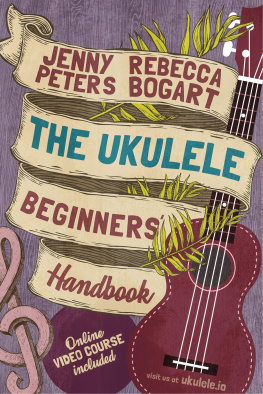
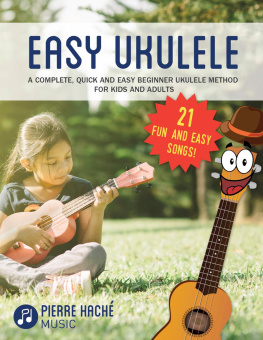


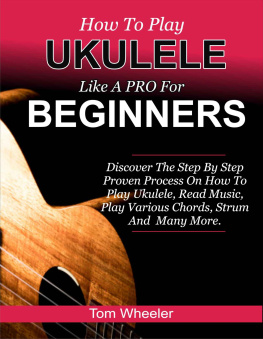
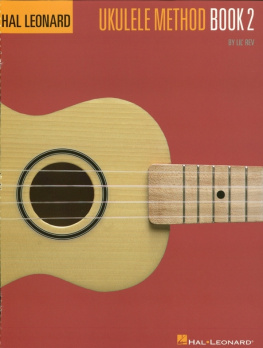
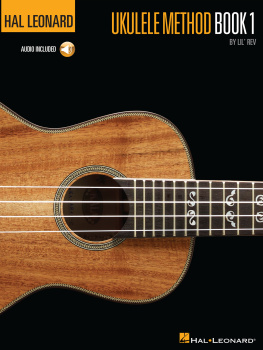
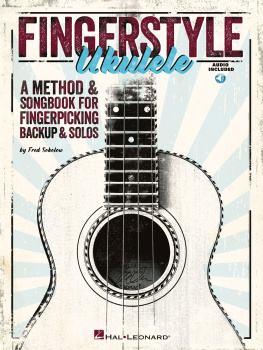
 Copyright 2016 Uke 'n' Roll LLC Uke 'n' Roll Volume 1: The Complete Ukulele Method All rights reserved. No part of this book may be reproduced, stored in a retrieval system, or transmitted by any means without the written permission of the authors. ISBN 978-0-9975340-0-9
Copyright 2016 Uke 'n' Roll LLC Uke 'n' Roll Volume 1: The Complete Ukulele Method All rights reserved. No part of this book may be reproduced, stored in a retrieval system, or transmitted by any means without the written permission of the authors. ISBN 978-0-9975340-0-9 VOLUME 1THE COMPLETE UKULELE METHOD by Samson Trinh & John Gonzalez del Solar
VOLUME 1THE COMPLETE UKULELE METHOD by Samson Trinh & John Gonzalez del Solar TABLE OF CONTENTS: SECTIONSTABLE OF CONTENTS: SONGSINTRODUCTION Featured in USA TODAY, Uke 'n' Roll provides an alternative teaching method to refresh the music program in school systems and inspire the community using the world's easiest, most engaging and addictive instrument the ukulele.
TABLE OF CONTENTS: SECTIONSTABLE OF CONTENTS: SONGSINTRODUCTION Featured in USA TODAY, Uke 'n' Roll provides an alternative teaching method to refresh the music program in school systems and inspire the community using the world's easiest, most engaging and addictive instrument the ukulele. THE BENEFITS OF THE UKULELE It's a small and inexpensive instrument that can fit any student, young or old. You can play and sing at the same time while gaining knowledge of music theory. The instrument is fun for teachers and students. Foundational springboard for those aspiring to learn a new instrument.
THE BENEFITS OF THE UKULELE It's a small and inexpensive instrument that can fit any student, young or old. You can play and sing at the same time while gaining knowledge of music theory. The instrument is fun for teachers and students. Foundational springboard for those aspiring to learn a new instrument. UKE HISTORY In 1880, Portuguese immigrants settled in Hawaii and introduced the islanders to a small stringed instrument called a machete. Three settlers in particular, Manuel Nunes, Jos do Esprito Santo, and Augusto Dias, all woodworkers, later modified the machete to what is now known as the ukulele (which translates to jumping flea and describes the movement of the player's fingers on the fretboard). The popularity of the ukulele in Hawaiian music and culture is credited to King David Kalkaua (b. November 16, 1836 d. January 20, 1891), who passionately supported and promoted the instrument in performances to royalty and the general public. His composition, Hawai'i Pono' is the state song of Hawaii. HOW TO SAY IT The Hawaiian pronunciation is "oo - koo - leh - lay" or "ook" for short.
UKE HISTORY In 1880, Portuguese immigrants settled in Hawaii and introduced the islanders to a small stringed instrument called a machete. Three settlers in particular, Manuel Nunes, Jos do Esprito Santo, and Augusto Dias, all woodworkers, later modified the machete to what is now known as the ukulele (which translates to jumping flea and describes the movement of the player's fingers on the fretboard). The popularity of the ukulele in Hawaiian music and culture is credited to King David Kalkaua (b. November 16, 1836 d. January 20, 1891), who passionately supported and promoted the instrument in performances to royalty and the general public. His composition, Hawai'i Pono' is the state song of Hawaii. HOW TO SAY IT The Hawaiian pronunciation is "oo - koo - leh - lay" or "ook" for short.
 HI! I'M SCRUFFY! You'll see me pop up in the book to offer ukulele knowledge, musical tips and help you Geek Out, which means to intensely examine a concept or technique in effort to master it! Just look for my banner and logo!
HI! I'M SCRUFFY! You'll see me pop up in the book to offer ukulele knowledge, musical tips and help you Geek Out, which means to intensely examine a concept or technique in effort to master it! Just look for my banner and logo!  THE UKULELE FAMILY The ukulele comes in four sizes.
THE UKULELE FAMILY The ukulele comes in four sizes.  The Uke 'n' Roll Method book can be used for soprano, concert, or tenor ukuleles because all three instruments use the same Standard Tuning of G-C-E-A, also known as C tuning. The Soprano is the smallest and perhaps the most popular size. It is perfect for children with small hands and fingers but many adults and experienced players love it, too. The sound is bright and the frets are closely spaced, making it ideal for beginners.
The Uke 'n' Roll Method book can be used for soprano, concert, or tenor ukuleles because all three instruments use the same Standard Tuning of G-C-E-A, also known as C tuning. The Soprano is the smallest and perhaps the most popular size. It is perfect for children with small hands and fingers but many adults and experienced players love it, too. The sound is bright and the frets are closely spaced, making it ideal for beginners. The Staff is the foundation of writing and reading notes and it's comprised of five lines and four spaces. TREBLE CLEF
The Staff is the foundation of writing and reading notes and it's comprised of five lines and four spaces. TREBLE CLEF The Treble Clef sign is placed at the beginning of the staff assigning notes to the lines and spaces. NOTES Each Note has a letter name and represents a different musical pitch. NOTES Each Note has a letter name and represents a different musical pitch.
The Treble Clef sign is placed at the beginning of the staff assigning notes to the lines and spaces. NOTES Each Note has a letter name and represents a different musical pitch. NOTES Each Note has a letter name and represents a different musical pitch. Sharp, Flat and Natural symbols are called Accidentals, and commonly occur in musical notation. Sharp (#) means to raise the pitch of the written note up by one half step (the distance of one fret higher in pitch). Flat (b) means to lower the pitch of the note by one half step.
Sharp, Flat and Natural symbols are called Accidentals, and commonly occur in musical notation. Sharp (#) means to raise the pitch of the written note up by one half step (the distance of one fret higher in pitch). Flat (b) means to lower the pitch of the note by one half step.